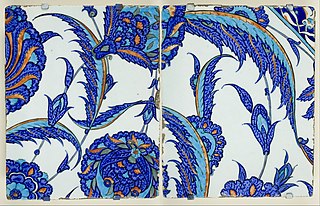 W
WMedieval Islamic pottery occupied a geographical position between Chinese ceramics, then the unchallenged leaders of Eurasian production, and the pottery of the Byzantine Empire and Europe. For most of the period it can fairly be said to have been between the two in terms of aesthetic achievement and influence as well, borrowing from China and exporting to and influencing Byzantium and Europe. The use of drinking and eating vessels in gold and silver, the ideal in ancient Rome and Persia as well as medieval Christian societies, is prohibited by the Hadiths, with the result that pottery and glass were used for tableware by Muslim elites, as pottery also was in China, but was much rarer in Europe and Byzantium. In the same way Islamic restrictions greatly discouraged figurative wall-painting, encouraging the architectural use of schemes of decorative and often geometrically-patterned tiles, which are the most distinctive and original speciality of Islamic ceramics.
 W
WChinese influences on Islamic pottery cover a period starting from at least the 8th century CE to the 19th century. This influence of Chinese ceramics has to be viewed in the broader context of the considerable importance of Chinese culture on Islamic arts in general.
 W
WFritware, also known as stone-paste, is a type of pottery in which frit is added to clay to reduce its fusion temperature. The mixture may include quartz or other siliceous material. An organic compound such as gum or glue may be added for binding. The resulting mixture can be fired at a lower temperature than clay alone. A glaze is then applied on the surface to harden the object.
 W
WHispano-Moresque ware is a style of initially Islamic pottery created in Al Andalus or Muslim Spain, which continued to be produced under Christian rule in styles blending Islamic and European elements. It was the most elaborate and luxurious pottery being produced in Europe until the Italian maiolica industry developed sophisticated styles in the 15th century, and was exported over most of Europe. The industry's most successful period was the 14th and 15th centuries.
 W
WIznik pottery, or Iznik ware, named after the town of İznik in western Anatolia where it was made, is a decorated ceramic that was produced from the last quarter of the 15th century until the end of the 17th century.
 W
WMiletus ware is a type of pottery that was produced in various locations in Anatolia between the late 14th and mid 15th centuries. The pottery was discovered through excavations in the 1930s by Friedrich Sarre at Miletus, hence the ware's name. This pottery type was not produced at Miletus, but in other towns such as İznik and Kütahya.
 W
WRaqqa ware or Rakka ware is a style of lustreware pottery that was a mainstay of the economy of Raqqa in northeastern Syria during the Ayyubid dynasty. Though the ceramics were varied in character, they have been identified during the 20th century by on-site excavations that securely linked the highly sought-after surviving pieces to Raqqa. However, Raqqa was not the only production site and Raqqa Ware has been found at various locations on the Euphrates, such as Qala'at Balis. The pieces typically have a white body covered in siliceous glaze, with decorations in brown luster or blue and back underglaze. The glazes most often vary in both transparency and shades of turquoise, however other colors were also used. Raqqa ware typically consists of kitchen items such as jars, dishes, and bowls with basic shapes that served everyday purposes such as storage. Some sculptural figures exist, and though their original purpose is debated, they are thought to be toys or decorations for the home.
 W
WSeljuq pottery was the pottery of the Seljuq Empire. With the end of the Seljuq Empire in the 14th century, the Ottoman Empire took over some of the traditions of the Seljuqs, especially in the early stages of İznik pottery.